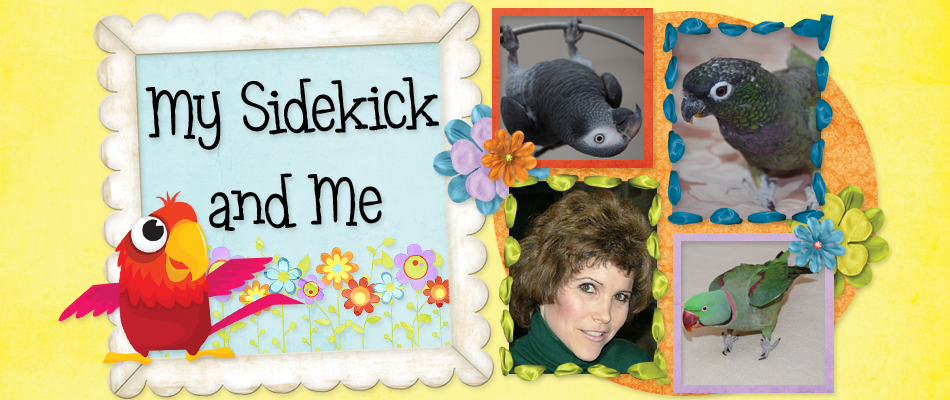
The feedback I received from people with whom I shared bits of that conversation – and the subsequent success I’ve had teaching my parents’ dog, Sam, was my positive reinforcement that has inspired me to want to write more about the subject.
Have you ever read Karen Pryor’s “Don’t Shoot The Dog”? It’s a really great book everyone who shares their home with an animal – including the human kind.
All too often, when a pet has behaved in an unacceptable way, we blame our pet. We assume our pet knows what we want him to do and he’s doing it because he is jealous or obstinate or mad. ‘My dog was mad at me for leaving.’ ‘My bird was jealous of my boyfriend.’ Have you ever made a comment like that? Bet you have. I know I did before I was enlightened.
What Jeni and Susan and others who use positive methods to teach recognize is that blaming or labeling the pet is really not going to be all that helpful in solving the problem. Although it is much easier to put a label on behavior, generally that label stops us in our tracks from working to find a solution. Instead, a much more productive approach is looking at the behavior in terms of what purpose it serves the animal. And, if your pet isn’t doing what you want him to do, it is your role to teach him.
Let me back up a second because this is important. Let’s think about it. Is it really possible to know what your pet is thinking or feeling? I may think my dog is mad or jealous but how can I really know? Heck, I can’t even figure men out. The only thing I do know for sure is that my pet is behaving, and for him to continue to behave in that way, he is being reinforced by something.
As a caretaker, and therefore trainer, I’ve come to realize that I can very effectively empower my pets to make decisions and modify their behavior in a way that will lead to their success while also improving their quality of life.
So, instead of just focusing on removing the problem behavior, now I look at the behavior in terms of ‘what’s in it’ for my pet. Is it possible that Sam stands up with two legs on the kitchen table during meals, not because he’s being bad, but because he learned that if he does, eventually the chances are good that he is either going to get human attention or a piece of something tasty? Or that Barnaby wasn’t stepping up because he knew that based on past experience, stepping up at the end of the night meant no more play time?
How can your pet be accountable for his behavior if you or something else in the environment gave that behavior purpose?
As Sam’s trainer then, I also can predict that when we sit down to eat, if Sam isn’t preoccupied with something else the chances are good he’s going to stand on the table. What are my options? Well, if we wait to feed him until we sit down that will keep him busy and satiated. I can also wrap his favorite bone in a newspaper and then in a sock, an activity that I know will keep his attention. And if all else fails and he comes to the table, I can completely ignore his standing up behavior and calmly tell him to sit. Then when he sits, I reinforce the heck out of it – with a treat AND praise. Life is pretty darned good for him when he chooses to sit by my side instead of jump up. Guess which behavior he will choose to do if I, as his trainer, am consistent in ignoring behavior I want to see less of and reinforcing behavior I want to see more of.
If, on the other hand, I chose to try and solve Sam’s jumping up behavior with punishment like a squirt bottle or a stern NO, do you think it would foster the same eagerness toward learning? Scientific data says no. Personal experience says no. Chances are it will also damage your relationship with your pet who will associate you with the punishment, can create apathy toward learning (that’s when you hear people call their pets dumb), and may even cause aggression.
Applied behavior Analysis is the process of solving practical behavior problems by changing the environment. It involves focusing tightly on the specific behavior you want to modify, and then looking at it in the context of its surroundings. What is giving that behavior purpose? What happened immediately prior to the behavior (antecedent) to set the wheels turning? What happened *immediately* after the behavior to reinforce it (consequence)?
When you look at the behavior in this way, you can begin to think about what needs to change in order to teach your pet what you want it to do. Positive reinforcement is all about arranging very motivating consequences to a behavior that are meaningful to the animal, while making sure you don’t inadvertently reward the wrong behavior. And one of the great perks to this kind of teaching strategy is that you’ll also notice your relationship with your pet grow as it associates you with that reward.
To read more about my behavior conversations with Jeni, please click here.
Wednesday, November 4, 2009
Positive Behavior Management In Pets
Subscribe to:
Post Comments (Atom)












0 comments:
Post a Comment